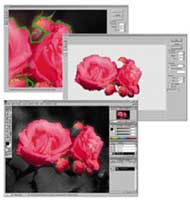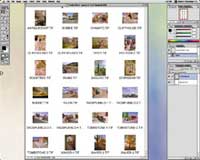New Adobe Photoshop
Times they are a changing; especially when it comes to what people are doing with images in response to the rapid development of new communications technologies like the web. More and more business, now called "e-commerce," has shifted to the Internet, including advertising of course. Because Adobe Photoshop remains the application of choice among professionals who deal with pictures digitally, Adobe has responded with a new version, Photoshop 5.5. Fortunately you don't have to be a professional, or a web content producer, to be advantaged by these new features included in Photoshop 5.5. Most are just as, if not more, valuable to doing work in the digital darkroom, editing, adjusting, manipulating, and compositing photographic images for fun as well as profit. This 5.5 upgrade is not at all minor, first of all because it incorporates a whole new application, ImageReady 2.0, which formally had been sold separately. ImageReady, which I reported at the time Photo-shop 5.0 was announced, is targeted at users who are creating image material for the web. It includes functions like making animated GIFs, converting image colors to web safe formats, as well as providing an acute method of specifying exact JPEG compression rates to preserve the best image quality at the smallest possible file size. For photographers who want to use compression for things other than web purposes, like attaching images to e-mail, or archiving images using storage space economically, ImageReady 2.0 is a must have utility. And, with an interface designed just like Photoshop it is easy to use, and to switch back and forth to and from Photoshop with the new Jump command. New Photoshop 5.5 Tools And Features. Although Adobe is classifying many of the new features in 5.5 as web creation tools, most have additional usefulness in a digital darkroom. For instance, one of these features is the ability to produce a contact sheet of image thumbnails by one command that includes all of the image files in a particular folder, processing each to a specified thumbnail size and page layout. Besides using this contact sheet creation tool for the web, it can just as easily be used to print an index page on paper for a collection of image CDs. Or, the contact sheet can be attached to an e-mail to convey easy visual identification of what's in a set of image files. A contact sheet of digital image files can be as useful as a traditional film/paper proof sheet, and more so. |
|||
There are many more new web specific tools in Photoshop 5.5 and ImageReady 2.0, like the ability to slice, create Java rollovers, and automatically generate HTML code. The tools traditionally inherent to Photoshop and elaborated in this Version 5.5, added to ImageReady 2.0 now as part of the package, provide the Photoshop user with the ability to design and create complete web pages, and ones that are quite ideally suited to support and display photographic images. Adobe Photoshop 5.5 shipped in July 1999 and is available for the first-time user at an estimated street price of $609. For current users of Photo-shop there is a promotional upgrade price of $129 after rebate available until May 2000. The standard upgrade price is $199. Using Adobe Photoshop 5.5 And ImageReady 2.0. Adobe's approach to new upgrades is to make the new features as accessible as possible without changing the tools and features of the previous version so the established, experienced user will not have to re-learn the application. This says a lot for the basic design, as the many new features fit in neatly and are logically situated, using commands and dialogs closely paralleling older established tools and features. The addition of a complete application in ImageReady 2.0 equally facilitates use by the experienced worker as the interface and the design of the commands and dialogs are virtually identical to Photoshop. Going from one Photoshop to ImageReady, or back, is as direct and easy as possible with a new Jump command in the file menu of each application, and which also supports jumping to other applications you may work with in conjunction with Photoshop like PageMaker or Illustrator. After installing Version 5.5 with the included ImageReady 2.0 on my Windows 98 workstation and my Macintosh blue G3, it took almost no time to begin using some of the new tools and features as if I'd been working with them for years. In fact because one of my favorite pastimes is compositing images to make photo collage pictures, the Extract tool was one of the first I tried. I found it worked ideally. It alone will save me a great deal of time otherwise spent in laborious hours hand selecting intricate images from their backgrounds. Another that worked easily and efficiently was Contact Sheet II, which efficiently generated a page of thumbnails with the file name imprinted below each. From the outset I was able to define a layout and resolution setting to result in a good quality letter size proof sheet print. This function, as I fill more and more CDRs with files of scanned images, will be used to make a quick reference book to find those images easily and locate the CD on which they are stored. Although I am personally not involved currently in web page creation I do a lot of image files for online access and send images frequently attached to e-mail, so ImageReady's ability to provide a side by side visual quality check to be able to fine-tune the selection of the best compression rate for each image is invaluable. For those photographers concerned about image presentation quality who are building and maintaining a web site, ImageReady will be a must have for many more reasons as well. |
|||
Evaluation And Recommendation. Although this particular version upgrade is apparently rather web-centric, the new features which are applicable to digital darkroom processing and creativity are many and substantial. The only qualification I would have is some of these functions are very processor and memory intensive, demanding a robust, speedy computer to run them efficiently. As usual, we are kept on the merry-go-round of upgrades to software and then hardware to keep up the performance. That price of progress I've found is worthwhile as Adobe continues to include with that progress, support for users to output more creative diversity in substantially better quality images. Economical Photoshop 5.0LE Now, particularly for those new to digital photography, getting into Photoshop with a 5.0LE version is immediately accessible and affordable with the release of 5.0LE through retail outlets for a street price of $99. In addition, those who already have a registered copy of Adobe PhotoDeluxe will be able to upgrade to Photoshop 5.0LE for just $79. So then what do you get in the Limited Edition of Photoshop 5 for your $99? First of all, it is Photoshop, and the engine that drives it is current and compatible with the latest Macintosh and Windows operating systems. It is Photoshop 5 basically without the features of 5.0/5.5 that were new to the version over what was current with Version 4.0. In other words, it is pretty much a modernized Version 4.0 functionally. And, this is no great disadvantage, at least from the perspective of even many professional Photoshop users who are still to this day using Version 4.0. From a photographer's perspective it has the basic image editing, manipulation, and compositing tools that have made the application the source of so much imagery published today. In fact for the less experienced or novice digital darkroom user, the Limited Edition may be an initial advantage over the full 5.0.2 or the newest 5.5 versions because it has fewer features and is therefore easier to learn to use. Again, from a photographer's perspective, 5.0LE has all of the necessary capabilities including full plug-in support so you can add filters or drivers for scanners if you are using the Macintosh version, and TWAIN driver support for input devices used with the Windows version. You can print from Photoshop using just about any output device supported by Mac or Windows. Photoshop 5.0LE does not have the internal color management introduced with the release of the full 5.0.2 version, but for input/output with a Macintosh with Colorsync or Windows 98 with ICM 2.0 good WYSIWYG image reproduction performance can be achieved, particularly if a calibrated monitor is used. For more information about Photoshop 5.0LE, and Version 5.5, call Adobe at (800) 492-3623 or visit their web site at: www.adobe.com/prodindex/photoshop/main.html |
- Log in or register to post comments




































